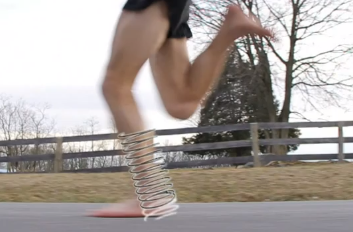
There is a lot of confusion around the term elastic recoil vs. braking in running. A critical feature of efficient running is a strong and stable base of support. Without this foundation, there can be no efficient transfer of energy.
Our tendons are highly adapted to storing and releasing energy under tensile strain. Jay Dicharry uses a slingshot analogy. As runners we must land a bit in front of our center of mass to store the energy and it then releases as we push off the ground. This is not braking if done correctly.
Can we tell what the runner is actually doing with a video camera? Not exactly as we cannot see forces?
But we can make some likely conclusions with slow-motion film as one can see a springy motion vs. a hard hit and resulting shock wave with an overstride. Muscles lengthen and shorten in the overstride and slow cadence pattern and compromise the elastic storage, as does trying to pick up your foot too soon with active muscle contraction (this is sprinting).
 Rewatch this video on the “Principles of Natural Running” here. Do some of the drills shown in the video such as the jump rope and run with tether drill to learn how to land closer to your center. Also a must read is “Anatomy for Runners” by Jay Dicharry.
Rewatch this video on the “Principles of Natural Running” here. Do some of the drills shown in the video such as the jump rope and run with tether drill to learn how to land closer to your center. Also a must read is “Anatomy for Runners” by Jay Dicharry.

I’ve been curious about this for a long time and have yet to see a clear description of elastic recoil. This article comes closest.
It would seem that elastic recoil ought to be visible as a returning wave ripple would be in a tank of water. If the ripple returns at exactly the same moment as the initiation of the next wave, there’d be an additive result. The more aligned the touchdown of the foot with the center of mass the more the full power of the recoil might be synchronized to meet the ground at the ideal time at a particular cadence.
An over-stride situation would seem to provide a vector leading to a forward rotational force around the center of mass that would require a countering move by the body, wasting energy.
If elastic return could be measured, it could be fed back and used to optimize running efficiency for anyone that would care to learn what their ideal cadence might be.
Thoughts?
John, thanks for the comment. this is really tough to measure in a lab but lots of analogies in nature exist. one just ned to do relaxed jump roping at their prefered cadence to fel this. for most it is betwen 170-180 steps/min. go faster and slower than this in your step count and feel the extra work.
Mark